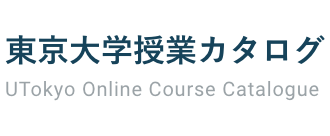過去(2022年度)の授業の情報です
学内のオンライン授業の情報漏洩防止のため,URLやアカウント、教室の記載は削除しております。
最終更新日:2025年4月21日
授業計画や教室は変更となる可能性があるため、必ずUTASで最新の情報を確認して下さい。
UTASにアクセスできない方は、担当教員または部局教務へお問い合わせ下さい。
最終更新日:2025年4月21日
授業計画や教室は変更となる可能性があるため、必ずUTASで最新の情報を確認して下さい。
UTASにアクセスできない方は、担当教員または部局教務へお問い合わせ下さい。
国際日本研究特論XXXII
「日本と太平洋と島々」/ Japan and the Pacific Ocean
海外から来ている学生との共同実習の場。学融合プログラム「グローバル・スタディーズ」の必修科目「グローバル教養実践演習II」との合併科目。
海外から東京大学に来ている多様なバックグラウンドを持つ学生たちとともに学び、活動の場を共有することを通して国際的な視野を身につけ、多言語・多文化的状況下での実践力を養うことを目指す。
「日本と太平洋と島々」をテーマとし、日本と太平洋という海洋空間を結びつける様々な歴史的事象、およびその今日への遺産について多角的にアプローチする。最初の4~5回は講義とディスカッションが中心となるが、その後はグループに分け、TAの補助の下に学生同士のプロジェクトベースのグループワークを中心に進める。グループワークにはグループの研究テーマに基づく、東京(近郊)におけるフィールドワークも含む場合がある。またグループワークの最終報告会を、授業最終日に行う。
This course aims to create a space for students from diverse backgrounds to work together to discover and explore unique historical associations between Japan, the Pacific Ocean and the countless islands in this ocean. Modern and contemporary Japan has been shaped by an array of catastrophic events unfolding in and across the Pacific, such as the arrival of the Black Ships, the explosion of nuclear armaments, the attack of Godzilla (!) and the Great East Japan Earthquake in March 2011. It has also been moulded by a variety of trans-Pacific practices initiated by the Japanese, ranging from emigration and colonial settlement across the islands and rims of this basin, the military occupation of ‘the South Seas’ (Nan’yō) and the Asia-Pacific war, to the postwar creation of regional forums like PECC that preceded today’s APEC and leisure tourism. Consequently, the Pacific Ocean is deeply inscribed in the identities of the people inhabiting the northwestern archipelagoes we stand on.
This course examines such multiple historical entanglements between Japan and the sea, simultaneously focusing on the question of what legacies they have left for the country and the people here. What material and psychological connections did cross-Pacific Japanese migrants create between their home and settlement countries, and what are today’s legacies of such connections? What memories have we inherited about the central Pacific islands which Japan administrated before and during the war? How have the people in Japan confronted or sought to coexist with the earthquake and tsunami? How and to what extent has March 2011 changed such consciousness for coexistence? More generally, in what ways have the people here imagined and represented the Pacific Ocean and the islands? How has such representation evolved and shifted? Students can approach these and many other questions from a variety of perspectives by examining, for example, relevant monuments, films, pictures and paints, narratives, and school textbooks, investigating the pertinent infrastructure that contributes to disaster prevention, exploring minority communities in Tokyo, or by conducting interviews etc (*certainly, all within the extent that does not take the high risks of Covid-19).
The course is a combination of in-class activity (i.e. lecture and discussion) and project-based group work initiated by students, with more stress on the latter. Teaching Assistants will provide advice and support for carrying out the group projects. All groups will participate in the final presentation at the end of the semester, which will take place at KOMCEE West Lecture Hall and will be open to public.
海外から東京大学に来ている多様なバックグラウンドを持つ学生たちとともに学び、活動の場を共有することを通して国際的な視野を身につけ、多言語・多文化的状況下での実践力を養うことを目指す。
「日本と太平洋と島々」をテーマとし、日本と太平洋という海洋空間を結びつける様々な歴史的事象、およびその今日への遺産について多角的にアプローチする。最初の4~5回は講義とディスカッションが中心となるが、その後はグループに分け、TAの補助の下に学生同士のプロジェクトベースのグループワークを中心に進める。グループワークにはグループの研究テーマに基づく、東京(近郊)におけるフィールドワークも含む場合がある。またグループワークの最終報告会を、授業最終日に行う。
This course aims to create a space for students from diverse backgrounds to work together to discover and explore unique historical associations between Japan, the Pacific Ocean and the countless islands in this ocean. Modern and contemporary Japan has been shaped by an array of catastrophic events unfolding in and across the Pacific, such as the arrival of the Black Ships, the explosion of nuclear armaments, the attack of Godzilla (!) and the Great East Japan Earthquake in March 2011. It has also been moulded by a variety of trans-Pacific practices initiated by the Japanese, ranging from emigration and colonial settlement across the islands and rims of this basin, the military occupation of ‘the South Seas’ (Nan’yō) and the Asia-Pacific war, to the postwar creation of regional forums like PECC that preceded today’s APEC and leisure tourism. Consequently, the Pacific Ocean is deeply inscribed in the identities of the people inhabiting the northwestern archipelagoes we stand on.
This course examines such multiple historical entanglements between Japan and the sea, simultaneously focusing on the question of what legacies they have left for the country and the people here. What material and psychological connections did cross-Pacific Japanese migrants create between their home and settlement countries, and what are today’s legacies of such connections? What memories have we inherited about the central Pacific islands which Japan administrated before and during the war? How have the people in Japan confronted or sought to coexist with the earthquake and tsunami? How and to what extent has March 2011 changed such consciousness for coexistence? More generally, in what ways have the people here imagined and represented the Pacific Ocean and the islands? How has such representation evolved and shifted? Students can approach these and many other questions from a variety of perspectives by examining, for example, relevant monuments, films, pictures and paints, narratives, and school textbooks, investigating the pertinent infrastructure that contributes to disaster prevention, exploring minority communities in Tokyo, or by conducting interviews etc (*certainly, all within the extent that does not take the high risks of Covid-19).
The course is a combination of in-class activity (i.e. lecture and discussion) and project-based group work initiated by students, with more stress on the latter. Teaching Assistants will provide advice and support for carrying out the group projects. All groups will participate in the final presentation at the end of the semester, which will take place at KOMCEE West Lecture Hall and will be open to public.
時間割/共通科目コード
コース名
教員
学期
時限
08C403332
FAS-CA4V34L3
国際日本研究特論XXXII
馬路 智仁
火曜2限
講義使用言語
英語
単位
2
実務経験のある教員による授業科目
NO
他学部履修
可
開講所属
教養学部
授業計画
The first four or five classes will be largely lecture-based and will be conducted in the classroom. This is a warm-up period. Then, students will be spending most of the time working together in groups to prepare for the final presentation.
The course places a major importance on group work. Students are expected to actively engage in group activities and contribute to the strengthening of teamwork. In carrying out the group project, each group will decide on a specific research topic, plan how to complete the research, analyse primary materials, conduct fieldwork if necessary, and demonstrate coordinated effort towards the final presentation.
There will be a few irregular classes (extended class time for film viewing, progress and final presentations) . The final schedule will be announced in the first class. Students can register after attending the first class.
授業の方法
Lectures, discussion, film viewing, group research, group presentation, fieldwork
成績評価方法
Class participation, group work, the quality of group presentation, and short final report.
Details will be given in class.
教科書
None
参考書
Provided or Instructed when necessary
履修上の注意
本授業は対面で行う予定である。参加者は不織布マスクを着用のこと。コロナとの関連で適切な理由により、対面が困難な学生は担当教員に事前に連絡してほしい。
This course will be conducted in person. Participants are required to wear non-woven masks. In relation to Covid-19, those students who feel a difficulty with in-person class for appropriate reasons are requested to contact the instructor in advance.
授業はすべて英語で行う。積極的に参加することが求められるが、英語能力についての条件はない。
後期課程の学生を歓迎する。登録方法その他の詳細は初回授業時に説明する。UTAS上の登録に加えて、初回授業での指示に従い別途Google Formに登録すること。(あくまで可能性としてであるが、実践型授業のため、履修登録者が非常に多い場合には人数制限することも想定される。)
Those who are interested in taking the course MUST COME TO THE FIRST CLASS. Instructions on signing up for the class will be given then. To be officially enrolled in this course, students must sign up in class. Please note that registering on UTAS does not automatically mean you will be enrolled.
その他
Notice:
1. This course requires NO preconditition of English proficiancy and fluency.
2. In this course, there are some classes beginning at 10am. For those students who have the 1st period that ends at the same hour (10am). it does NOT matter if they come to the classroom 5 to 10 minutes late.





 学部後期課程
学部後期課程

 マイリストに追加
マイリストに追加
 マイリストから削除
マイリストから削除


